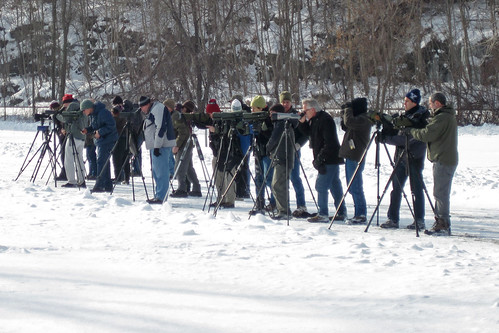 |
| The Pochard that started it all! |
It all started on New Year’s day with two of Vermont’s
finest birders. “I think I’ve got a
Redhead,” said Ian Worley to Ron Payne.
They had been examining a large flock of waterfowl at the Champlain
Bridge at Crown Point. It looked a
little off, but with no other look-alikes in their field guide, they decided
the duck they saw was in fact a Redhead.
Not until a picture was posted on the web did they discover that this
bird was actually a European duck called a Common Pochard.
After its discovery was made public, three things
happened. The first was that birders
flocked to the Champlain Bridge from all over New England (and beyond!) Visitors from as far away as West Virginia
and North Carolina made the trip to Vermont to see the Pochard. The volume of visitors was so high that the
state of Vermont decided to re-open D.A.R. State Park (typically closed in
winter) to accommodate the influx of birders.
 |
| A group of birders from throughout the northeast viewing the Common Pochard from Port Henry, NY. |
The next thing to happen was the “Patagonia Picnic Table
Effect.” This term was coined in 1971
after a group of birders passing though Patagonia, AZ discovered the first
Black-tailed Gnatcatcher in U.S. history at a small rest stop off RT-82. The slew of birders that followed in their
wake to see the gnatcatcher ended up discovering the first U.S. record of
Yellow Grosbeak at the same rest stop!
Hence, the effect was born. Rare
birds attract good birders who discover more rare birds. This phenomenon took place in Vermont, with Pochard-searchers
recording many more rarities at the Champlain Bridge, such as Canvasback,
Iceland Gull, Barrow’s X Common Goldeneye hybrid, and more.
The final thing to happen was a great debate. As the Pochard lifted its leg out of the
water to take flight, someone noticed a metal band around its leg. This band could have been placed by a researcher
in Europe, but it could have also been placed by the owner of domestic
waterfowl. With the discovery of the
band, the bird’s origin was put into question.
Was this a wild bird, the first ever recorded in the eastern US? Or was
this an escapee from a backyard in upstate New York? Whatever the bird’s origin, it has put
Vermont ‘on the map’ for birders throughout the Northeast and many continue to
make the trip to the Champlain Bridge to see the Pochard and other waterfowl.
Text and photos by Larry Clarfeld
For an account of the original discovery of the Pochard, visit Otter Creek Audubon Society.
Text and photos by Larry Clarfeld
For an account of the original discovery of the Pochard, visit Otter Creek Audubon Society.

No comments:
Post a Comment